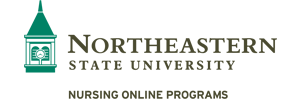The nurse shortage is well-publicized. While shortages may vary from state to state, one thing is clear: the nursing shortage is causing considerable concern about the quality and safety of patient care.
Compounding the shortage is the trend of hospitals and other healthcare organizations preferring RNs with a Bachelor of Science in Nursing (BSN). For nurses who entered the profession with an associate degree or diploma, an RN to BSN is the next step.
The online RN to BSN program at Northeastern State University (NSU), for example, builds on a nurse’s previous education and experience, providing preparation for professional nursing practice in as few as 10 months.
What Does the Nursing Shortage Look Like?
Nursing is the nation’s largest healthcare occupation. According to the American Association of Colleges of Nursing (AACN), there are 3.8 million RNs in the U.S. Even with the size of the nursing workforce, supply is not meeting demand. But the shortage is not new.
The Pew Research Center reported on the nursing shortage over a decade ago. Janet Haebler, associate director for Policy and State Government Affairs for the American Nurses Association (ANA), commented on the shortage, saying, “I’ve been in this business for 37 years; there’s been a shortage every year.”
According to the U.S. Bureau of Labor Statistics (BLS), the projected need for RNs averages more than 200,000 openings each year from 2016 to 2026. This far exceeds the demand for other occupations that typically require a bachelor’s degree, such as engineers and accountants.
The Health Resources and Services Administration (HRSA) describes significant geographic differences in RN supply and demand. For instance, a shortage of 3,700 Full-Time Equivalents (FTEs) is projected for California by 2025. Florida may see a surplus of 4,200 FTEs.
Another way to look at the shortage is the number of employed RNs per capita. According to a National Council of State Boards of Nursing (NCSBN) report, for example, California, Nevada, Utah, Oklahoma and Georgia have the fewest RNs per capita: 600 to 700 RNs per 100,000 people.
What Is Driving the Need for More Nurses?
While some employment sectors are slowing down, healthcare is seeing some of the fastest growth. RNs are in high demand, with projected job growth of 12% from 2018 to 2028. This is more than double the average growth rate for all occupations of 5%.
Based on an AACN fact sheet, factors that contribute to the nursing shortage include:
- Baby Boomers who are living longer and typically require more health services than younger people
- Growing numbers of people with chronic conditions such as diabetes
- More than one million RNs reaching retirement age within 10 to 15 years
- A nursing faculty shortage
The faculty shortage may be the most critical factor. In 2018, more than 75,000 qualified applicants were turned away from BSN and graduate nursing programs due to the lack of faculty to teach them. The need for faculty is so great that nurse educators are on the BLS list of the top 30 fastest growing occupations.
Finally, a changing healthcare system also contributes to the need for more RNs. Nurses are taking on new roles and responsibilities across the healthcare sector. Advances in healthcare, such as with genetics and genomics, are also creating exciting new roles for RNs to fill.
How Does the Shortage Impact Patients?
A nursing shortage means that healthcare organizations are often short-staffed. Overtime is a standard practice for nurses and may even be mandatory. But long work hours lead to fatigue. This may result in what the American Nurses Association (ANA) refers to as “performance deficits” such as:
- Increased risk of error
- Decrease in short-term and working memory
- Reduced ability to learn
- Negative impact on divergent thinking, innovation and insight
- Increased risk-taking
- Impaired mood and communication skills
One study found that nurses who are fatigued are more likely to report clinical decision regret. In other words, the care delivered did not meet professional nursing practice standards or expectations.
An AACN fact sheet summarizes additional research on staffing levels and patient safety. One study found that increasing a nurse’s workload by just one patient increased the likelihood of the patient dying within 30 days of admission by 7%. Research also links higher nurse staffing levels to positive patient outcomes, including:
- Fewer deaths
- Lower failure-to-rescue incidents
- Lower rates of infection
- Shorter hospital stays
- Lower readmission rates
How Is the Nursing Shortage Being Addressed?
Efforts are underway to tackle the nurse shortage, and many states are making progress. Educating more nurses is an important part of the solution. According to the NCSBN, the entry of new RNs into the workforce could offset the wave of retiring nurses.
RN to BSN programs play an important role in meeting the need for nurses with higher levels of education. RN to BSN programs are typically offered online, which means RNs can earn their degree without leaving their jobs. This may be especially helpful in rural areas where shortages are often more acute.
In support of meeting the national goal of an 80% BSN-prepared workforce by 2020, the AACN notes that some hospitals provide financial incentives to RNs who go on to earn a BSN. Loan forgiveness programs may be another option.
RNs can help ease the nursing shortage by earning their BSN. A BSN also puts RNs on the path to becoming nurse educators. Stepping up to educate future generations of RNs may be the single most important contribution a nurse can make to help ensure adequate staffing and patient safety.
Learn more about Northeastern State University’s online RN to BSN program.


